Abacus: Difference between revisions
No edit summary |
Reverted good faith edits by 68.199.32.162; Unsourced. (TW) |
||
| Line 2: | Line 2: | ||
[[Image:Boulier1.JPG|right|thumb|A Chinese abacus]] |
[[Image:Boulier1.JPG|right|thumb|A Chinese abacus]] |
||
[[Image:Gregor Reisch, Margarita Philosophica, 1508 (1230x1615).png|right|thumb|250px|'''Calculating-Table by Gregor Reisch: Margarita Philosophica, 1508'''. The woodcut shows ''Arithmetica'' instructing an [[algorism|algorist]] and an abacist (inaccurately represented as [[Boethius]] and [[Pythagoras]]). There was keen competition between the two from the introduction of the ''[[The Compendious Book on Calculation by Completion and Balancing|Algebra]]'' into Europe in the 12th century until its triumph in the 16th.<ref>Carl B. Boyer, ''A History of Mathematics'', pp252-253, Wiley, 1991.</ref>]] |
[[Image:Gregor Reisch, Margarita Philosophica, 1508 (1230x1615).png|right|thumb|250px|'''Calculating-Table by Gregor Reisch: Margarita Philosophica, 1508'''. The woodcut shows ''Arithmetica'' instructing an [[algorism|algorist]] and an abacist (inaccurately represented as [[Boethius]] and [[Pythagoras]]). There was keen competition between the two from the introduction of the ''[[The Compendious Book on Calculation by Completion and Balancing|Algebra]]'' into Europe in the 12th century until its triumph in the 16th.<ref>Carl B. Boyer, ''A History of Mathematics'', pp252-253, Wiley, 1991.</ref>]] |
||
The '''abacus''', also called a '''counting frame''', is a calculating tool used primarily in parts of Asia for performing [[arithmetic]] processes. Today, abacuses are often constructed as a bamboo frame with beads sliding on wires, but originally they were beans or stones moved in grooves in sand or on tablets of wood, stone, or metal. The abacus was in use centuries before the adoption of the written modern numeral system and is still widely used by merchants, traders and clerks in [[Asia]], [[Africa]], and elsewhere. The user of an abacus is called an abacist.<ref>"abacist", |
The '''abacus''', also called a '''counting frame''', is a calculating tool used primarily in parts of Asia for performing [[arithmetic]] processes. Today, abacuses are often constructed as a bamboo frame with beads sliding on wires, but originally they were beans or stones moved in grooves in sand or on tablets of wood, stone, or metal. The abacus was in use centuries before the adoption of the written modern numeral system and is still widely used by merchants, traders and clerks in [[Asia]], [[Africa]], and elsewhere. The user of an abacus is called an abacist.<ref>"abacist", "abacus", in Merriam-Webster's Third New International Dictionary Unabridged, 2000, Version 2.5.</ref> |
||
==Etymology== |
==Etymology== |
||
Revision as of 22:10, 27 March 2010
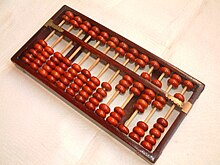

The abacus, also called a counting frame, is a calculating tool used primarily in parts of Asia for performing arithmetic processes. Today, abacuses are often constructed as a bamboo frame with beads sliding on wires, but originally they were beans or stones moved in grooves in sand or on tablets of wood, stone, or metal. The abacus was in use centuries before the adoption of the written modern numeral system and is still widely used by merchants, traders and clerks in Asia, Africa, and elsewhere. The user of an abacus is called an abacist.[2]
Etymology
The use of the word abacus dates before 1387 AD, when a Middle English work borrowed the word from Latin to describe a sandboard abacus. The Latin word came from abakos, the Greek genitive form of abax ("calculating-table"), from Hebrew ābāq (אבק), "dust".[3] The preferred plural of abacus is a subject of disagreement, with both abacuses[4] and abaci[5] in use.
Mesopotamian abacus
The period 2700–2300 BC saw the first appearance of the Sumerian abacus, a table of successive columns which delimited the successive orders of magnitude of their sexagesimal number system.[6]
Some scholars point to a character from the Babylonian cuneiform which may have been derived from a representation of the abacus.[7] It is the belief of Carruccio (and other Old Babylonian scholars) that Old Babylonians "may have used the abacus for the operations of addition and subtraction; however, this primitive device proved difficult to use for more complex calculations".[8]
Egyptian abacus
The use of the abacus in Ancient Egypt is mentioned by the Greek historian Herodotus, who writes that the manner of this disk's usage by the Egyptians was opposite in direction when compared with the Greek method. Archaeologists have found ancient disks of various sizes that are thought to have been used as counters. However, wall depictions of this instrument have not been discovered, casting some doubt over the extent to which this instrument was used.[9]
Iranian Persian abacus
During the Achaemenid Persian Empire, around 600 BC, Iranians first began to use the abacus.[10] Under Parthian and Sassanian Iranian empires, scholars concentrated on exchanging knowledge and inventions by the countries around them – India, China, and the Roman Empire, when it is thought to be expanded over the other countries.
Greek abacus
The earliest archaeological evidence for the use of the Greek abacus dates to the 5th century BC.[11] The Greek abacus was a table of wood or marble, pre-set with small counters in wood or metal for mathematical calculations. This Greek abacus saw use in Achaemenid Persia, the Etruscan civilization, Ancient Rome and, until the French Revolution, the Western Christian world.
A tablet found on the Greek island Salamis in 1846 AD dates back to 300 BC, making it the oldest counting board discovered so far. It is a slab of white marble 149 cm (59 in) long, 75 cm (30 in) wide, and 4.5 cm (2 in) thick, on which are 5 groups of markings. In the center of the tablet is a set of 5 parallel lines equally divided by a vertical line, capped with a semicircle at the intersection of the bottom-most horizontal line and the single vertical line. Below these lines is a wide space with a horizontal crack dividing it. Below this crack is another group of eleven parallel lines, again divided into two sections by a line perpendicular to them, but with the semicircle at the top of the intersection; the third, sixth and ninth of these lines are marked with a cross where they intersect with the vertical line.
Roman abacus
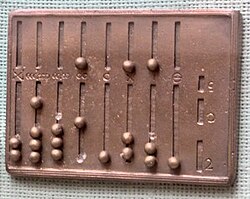
The normal method of calculation in ancient Rome, as in Greece, was by moving counters on a smooth table. Originally pebbles, calculi, were used. Later, and in medieval Europe, jetons were manufactured. Marked lines indicated units, fives, tens etc. as in the Roman numeral system. This system of 'counter casting' continued into the late Roman empire and in medieval Europe, and persisted in limited use into the nineteenth century.[12]
Writing in the 1st century BC, Horace refers to the wax abacus, a board covered with a thin layer of black wax on which columns and figures were inscribed using a stylus.[13]
One example of archaeological evidence of the Roman abacus, shown here in reconstruction, dates to the 1st century AD. It has eight long grooves containing up to five beads in each and eight shorter grooves having either one or no beads in each. The groove marked I indicates units, X tens, and so on up to millions. The beads in the shorter grooves denote fives –five units, five tens etc., essentially in a bi-quinary coded decimal system, obviously related to the Roman numerals. The short grooves on the right may have been used for marking Roman ounces.
Chinese abacus
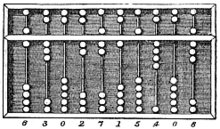
The earliest known written documentation of the Chinese abacus dates to the 2nd century BC.[14]
The Chinese abacus, known as the suànpán(算盤, lit. "Counting tray"), is typically 20 cm (8 in) tall and comes in various widths depending on the operator. It usually has more than seven rods. There are two beads on each rod in the upper deck and five beads each in the bottom for both decimal and hexadecimal computation. The beads are usually rounded and made of a hardwood. The beads are counted by moving them up or down towards the beam. If you move them toward the beam, you count their value. If you move away, you don't count their value.[15] The suanpan can be reset to the starting position instantly by a quick jerk along the horizontal axis to spin all the beads away from the horizontal beam at the center.
Suanpans can be used for functions other than counting. Unlike the simple counting board used in elementary schools, very efficient suanpan techniques have been developed to do multiplication, division, addition, subtraction, square root and cube root operations at high speed. There are currently schools teaching students how to use it.
In the famous long scroll Along the River During the Qingming Festival painted by Zhang Zeduan (1085–1145 AD) during the Song Dynasty (960–1297 AD), a suanpan is clearly seen lying beside an account book and doctor's prescriptions on the counter of an apothecary's (Feibao).
The similarity of the Roman abacus to the Chinese one suggests that one could have inspired the other, as there is some evidence of a trade relationship between the Roman Empire and China. However, no direct connection can be demonstrated, and the similarity of the abaci may be coincidental, both ultimately arising from counting with five fingers per hand. Where the Roman model (like most modern Japanese) has 4 plus 1 bead per decimal place, the standard suanpan has 5 plus 2, allowing use with a hexadecimal numeral system. Instead of running on wires as in the Chinese and Japanese models, the beads of Roman model run in grooves, presumably making arithmetic calculations much slower.
Another possible source of the suanpan is Chinese counting rods, which operated with a decimal system but lacked the concept of zero as a place holder. The zero was probably introduced to the Chinese in the Tang Dynasty (618-907 AD) when travel in the Indian Ocean and the Middle East would have provided direct contact with India, allowing them to acquire the concept of zero and the decimal point from Indian merchants and mathematicians.
Indian abacus
First century sources, such as the Abhidharmakosa describe the knowledge and use of abacus in India.[16] Around the 5th century, Indian clerks were already finding new ways of recording the contents of the Abacus.[17] Hindu texts used the term shunya (zero) to indicate the empty column on the abacus..[18]
Japanese abacus

In Japanese, the abacus is called soroban (算盤, そろばん, lit. "Counting tray"), imported from China around 1600.[19] The 1/4 abacus appeared circa 1930, and it is preferred and still manufactured in Japan today even with the proliferation, practicality, and affordability of pocket electronic calculators. The use of the soroban is still taught in Japanese primary schools as a part of mathematics.
Korean abacus
The Chinese abacus migrated from China to Korea around 1400 AD.[20] Koreans call it jupan (주판), supan (수판) or jusan (주산).[21]
Native American abaci

Some sources mention the use of an abacus called a nepohualtzintzin in ancient Mayan culture. This Mesoamerican abacus used a 5-digit base-20 system.[22] The word Nepohualtzintzin comes from the Nahuatl and it is formed by the roots; Ne - personal -; pohual or pohualli - the account -; and tzintzin - small similar elements. And its complete meaning is taken as: counting with small similar elements by somebody. Its use was taught in the "Kalmekak" to the "temalpouhkeh", who were students dedicated to take the accounts of skies, from childhood. Unfortunately the Nepohualtzintzin and its teaching were among the victims of the conquering destruction, when a diabolic origin was attributed to them after observing the tremendous properties of representation, precision and speed of calculations.[citation needed].
This arithmetic tool is based on the vigesimal system (base 20).[23] For the aztec the count by 20s was completely natural, since the use of "huaraches" (native sandals) allowed them to also use the toes for their calculations. In this way, the amount of 20 meant to them a complete human being. The Nepohualtzintzin is divided in two main parts separated by a bar or intermediate cord. In the left part there are four beads, which in the first row have unitary values (1, 2, 3, and 4), and in the right side there are three beads with values of 5, 10, and 15 respectively. In order to know the value of the respective beads of the upper rows, it is enough to multiply by 20 (by each row), the value of the corresponding account in the first row.
Altogether, there are 13 rows with 7 beads in each one, which makes up 91 beads in each Nepohualtzintzin. This is a basic number to understand the close relation conceived between the exact accounts and the natural phenomena. This is so that one Nepohualtzintzin (91) represents the number of days that a season of the year lasts, two Nepohualtzitzin (182) is the number of days of the corn's cycle, from its sowing to its harvest, three Nepohualtzintzin (273) is the number of days of a baby's gestation, and four Nepohualtzintzin (364) complete a cycle and approximate a year (1 1/4 days short). It is worth to mention that in the Nepohualtzintzin, amounts in the rank from 10 to the 18 can be calculated, with floating point, which allows calculating stellar as well as infinitesimal amounts with absolute precision.
The rediscovering of the Nepohualtzintzin is due to the teacher David Esparza Hidalgo[citation needed], who in his wandering by all Mexico has found diverse engravings and paintings of this instrument and has reconstructed several of them made in gold, jade, incrustations of shell, etc [citation needed]. There have also been found very old Nepohualtzintzin attributed to the Olmeca culture, and even some bracelets of Mayan origin, as well as a diversity of forms and materials in other cultures.
The quipu of the Incas was a system of knotted cords used to record numerical data, like advanced tally sticks – but not used to perform calculations. Calculations were carried out using a yupana (quechua for "counting tool"; see figure) which was still in use after the conquest of Peru. The working principle of a yupana is unknown, but in 2001 an explanation of the mathematical basis of these instruments was proposed.[who?] By comparing the form of several yupanas, researchers found that calculations were based using the Fibonacci sequence 1, 1, 2, 3, 5 and powers of 10, 20 and 40 as place values for the different fields in the instrument. Using the Fibonacci sequence would keep the number of grains within any one field at minimum.
Russian abacus
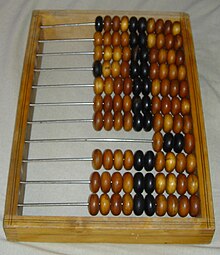
The Russian abacus, the schety (счёты), usually has a single slanted deck, with ten beads on each wire (except one wire which has four beads, for quarter-ruble fractions. This wire is usually near the user). (Older models have another 4-bead wire for quarter-kopeks, which were minted until 1916.) The Russian abacus is often used vertically, with wires from left to right in the manner of a book. The wires are usually bowed to bulge upward in the center, to keep the beads pinned to either of the two sides. It is cleared when all the beads are moved to the right. During manipulation, beads are moved to the left. For easy viewing, the middle 2 beads on each wire (the 5th and 6th bead) usually are of a different colour from the other eight beads. Likewise, the left bead of the thousands wire (and the million wire, if present) may have a different color.
As a simple, cheap and reliable device, the Russian abacus was in use in all shops and markets throughout the former Soviet Union, and the usage of it was taught in most schools until the 1990s.[24][25] Even the 1874 invention of mechanical calculator, Odhner arithmometer, had not replaced them in Russia and likewise the mass production of Felix arithmometers since 1924 did not significantly reduce their use in the Soviet Union.[26] Russian abacus began to lose popularity only after the mass production of microcalculators had started in the Soviet Union in 1974. On Today it is regarded as an archaism and replaced by microcalculator.
The Russian abacus was brought to France around 1820 by the mathematician Jean-Victor Poncelet, who served in Napoleon's army and had been a prisoner of war in Russia.[27] The abacus had fallen out of use in western Europe in the 16th century with the rise of decimal notation and algorismic methods. To Poncelet's French contemporaries, it was something new. Poncelet used it, not for any applied purpose, but as a teaching and demonstration aid.[28]
 |
 |
 | ||
| Digits | Addition | Subtraction |
School abacus
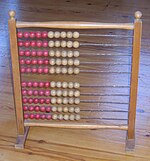
Around the world, abaci have been used in pre-schools and elementary schools as an aid in teaching the numeral system and arithmetic.
In Western countries, a bead frame similar to the Russian abacus but with straight wires and a vertical frame has been common (see image). It is still often seen as a plastic or wooden toy.
The type of abacus shown here is often used to represent numbers without the use of place value. Each bead and each wire has the same value and used in this way it can represent numbers up to 100.
Abaci in Renaissance pictures
Uses by the blind
An adapted abacus, invented by Tim Cranmer, called a Cranmer abacus is still commonly used by individuals who are blind. A piece of soft fabric or rubber is placed behind the beads so that they do not move inadvertently. This keeps the beads in place while the users feel or manipulate them. They use an abacus to perform the mathematical functions multiplication, division, addition, subtraction, square root and cubic root.[29]
Although blind students have benefited from talking calculators, the abacus is still very often taught to these students in early grades, both in public schools and state schools for the blind. The abacus teaches mathematical skills that can never be replaced with talking calculators and is an important learning tool for blind students. Blind students also complete mathematical assignments using a braille-writer and Nemeth code (a type of braille code for mathematics) but large multiplication and long division problems can be long and difficult. The abacus gives blind and visually impaired students a tool to compute mathematical problems that equals the speed and mathematical knowledge required by their sighted peers using pencil and paper. Many blind people find this number machine a very useful tool throughout life.[29]
Binary Abacus

An abacus that explains how computers manipulate numbers.[30]
The abacus shows how numbers, letters, and signs can be stored in a binary system on a computer, or via ASCII.
The device consists of a series of beads on parallel wires arranged in three separate rows. The beads represent a switch on the computer in either an 'on' or 'off' position.
In 1985, Dr. Robert C. Good, Jr. of the Widener University School of Engineering published a paper on the binary abacus.
See also
Notes
- ^ Carl B. Boyer, A History of Mathematics, pp252-253, Wiley, 1991.
- ^ "abacist", "abacus", in Merriam-Webster's Third New International Dictionary Unabridged, 2000, Version 2.5.
- ^ Douglas Harper, Online Etymology Dictionary, retrieved 2009-09-19
- ^ Oxford English Dictionary 1989
- ^ Merriam-Webster's 2003
- ^ Ifrah 2001:11
- ^ Crump 1992:188
- ^ Carruccio 2006:14
- ^ Smith 1958:160
- ^ West Asian Mathematics - History for Kids!
- ^ Ifrah 2001:15
- ^ Pullan, page18
- ^ Ifrah 2001:18
- ^ Ifrah 2001:17
- ^ Fernandes, Luis (November 27, 2003), "A Brief Introduction to the Abacus", ee.ryerson.ca, retrieved 2009-10-24
- ^ Stearns & Langer 2001:44
- ^ Körner & Langer 1996:232
- ^ Mollin 1998:3
- ^ Fernandes, Luis, The Abacus: A Brief History
- ^ abacus
- ^ 주판 : Daum 백과사전
- ^ http://www.inaoep.mx/iberamia2004/nepo_eng.htm
- ^ http://www.tux.org/~bagleyd/java/AbacusAppMA.html
- ^ Robert Bud, Deborah Jean Warner (eds.), Instruments of science: an historical encyclopedia, p7, Taylor & Francis, 1998 ISBN 0815315619.
- ^ Sharon Hudgins, The Other Side of Russia, p219, Texas A&M University Press, 2004 ISBN 1585444049.
- ^ A. M. Leushina, The development of elementary mathematical concepts in preschool children, p427, National Council of Teachers of Mathematics, 1991 ISBN 0873532996
- ^ Georg Trogemann, Alexander Y. Nitussov, Wolfgang Ernst, Computing in Russia: The History of Computer Devices and Information Technology Revealed, p24, Vieweg+Teubner Verlag, 2001 ISBN 3528057572.
- ^ Graham Flegg, Numbers: Their History and Meaning, p72, Courier Dover Publications, 2002 ISBN 0486421651.
- ^ a b Terlau, Terrie (July 20, 2006), Abacus: Position Paper, APH.org, retrieved 2009-10-23
{{citation}}: Unknown parameter|coauthors=ignored (|author=suggested) (help) - ^ Good, Dr. Robert C, Jr. The Binary Abacus: A Useful Tool for Explaining Computer Operations, Journal of Computers in Mathematics and Science Teaching, Fall 1985.
References
- Carruccio, Ettore (2006), Mathematics And Logic in History And in Contemporary Thought, Aldine Transaction, ISBN 0202308502.
- Crump, Thomas (1992), The Japanese Numbers Game: The Use and Understanding of Numbers in Modern Japan, Routledge, ISBN 0415056098.
- Ifrah, Georges (2001), The Universal History of Computing: From the Abacus to the Quantum Computer, New York: John Wiley & Sons.
- Körner, Thomas William; Langer, William Leonard (1996), The Pleasures of Counting, Houghton Mifflin Books, ISBN 0521568234.
- Mollin, Richard Anthony (1998), Fundamental Number Theory with Applications, CRC Press, ISBN 0849339871
{{citation}}: Unknown parameter|month=ignored (help). - Peng Yoke Ho (2000), Li, Qi and Shu: An Introduction to Science and Civilization in China, Courier Dover Publications, ISBN 0486414450.
- Pullan, J. M. (1968), The History of the Abacus, London: Books That Matter, ISBN 0-09-089410-3.
- Reilly, Edwin D.; Langer, William Leonard (2004), Concise Encyclopedia of Computer Science, John Wiley and Sons, ISBN 0470090952.
- Smith, David Eugene (1958), History of Mathematics (Volume 2), Courier Dover Publications, ISBN 0486204308.
- Stearns, Peter N.; Langer, William Leonard (2001), The Encyclopedia of World History: Ancient, Medieval, and Modern, Chronologically Arranged, Houghton Mifflin Books, ISBN 0395652375.
- Mish, Frederick C., ed. (2003), Merriam-Webster's Collegiate Dictionary (11th ed.), Merriam-Webster, Inc, ISBN 0877798095.
- "abacus". Oxford English Dictionary (Online ed.). Oxford University Press. (Subscription or participating institution membership required.)
Further reading
- Menninger, Karl W. (1969), Number Words and Number Symbols: A Cultural History of Numbers, MIT Press, ISBN 0-262-13040-8.
- Kojima, Takashi (1954), The Japanese Abacus: its Use and Theory, Tokyo: Charles E. Tuttle, ISBN 0-8048-0278-5.
External links
Tutorials
- Min Multimedia
- Sung, Dylan W.H., Suan Pan
- Heffelfinger, Totton & Gary Flom, Abacus: Mystery of the Bead - an Abacus Manual
Abacus curiosities
- Schreiber, Michael (2007), Abacus, The Wolfram Demonstrations Project
- Abacus in Various Number Systems at cut-the-knot
- Java applet of Chinese, Japanese and Russian abaci
- An atomic-scale abacus









